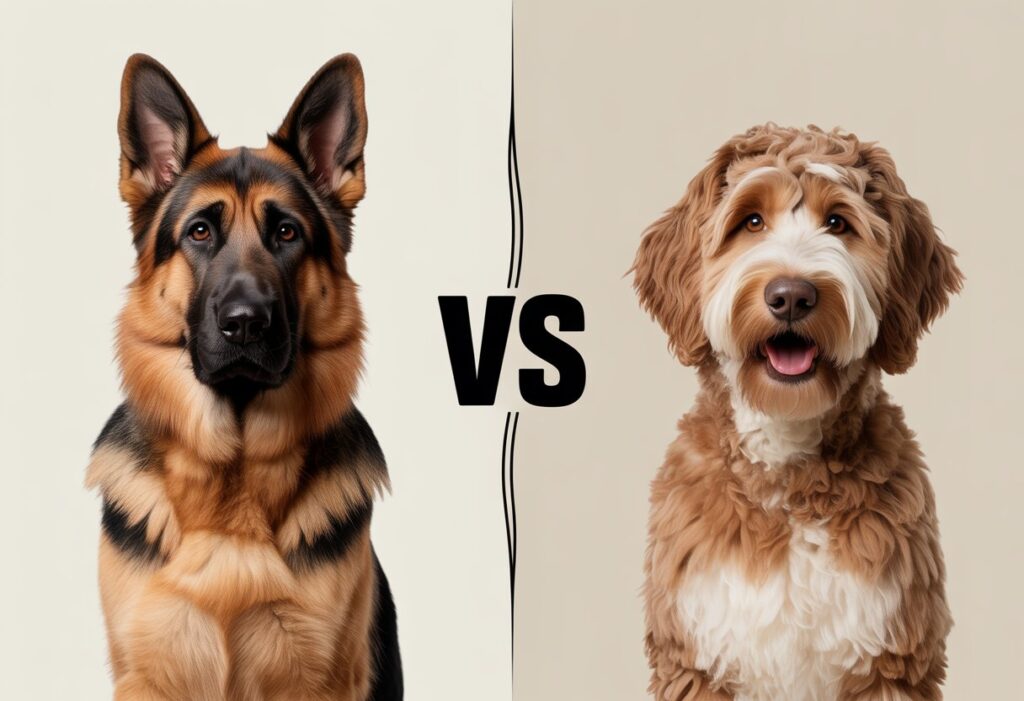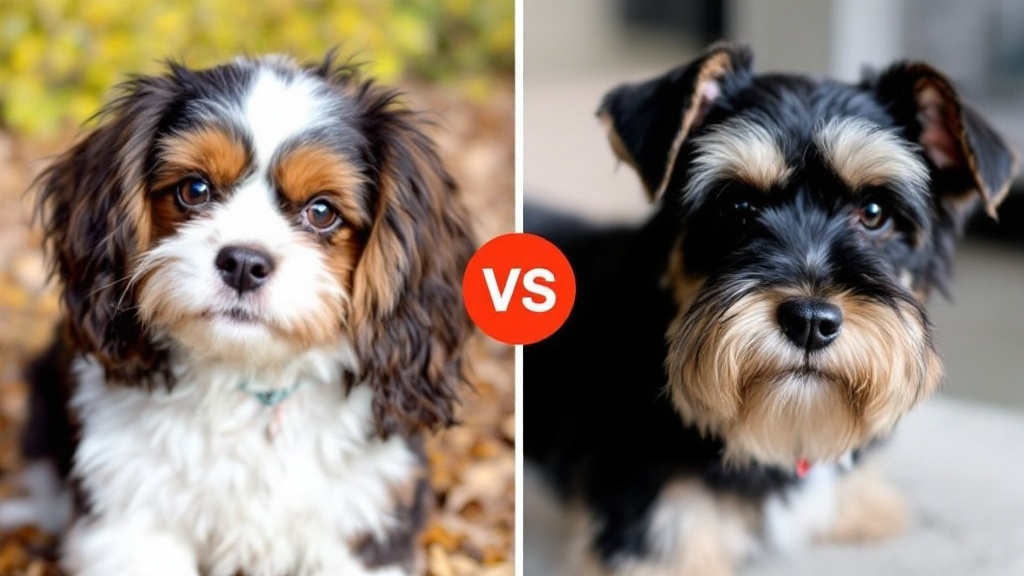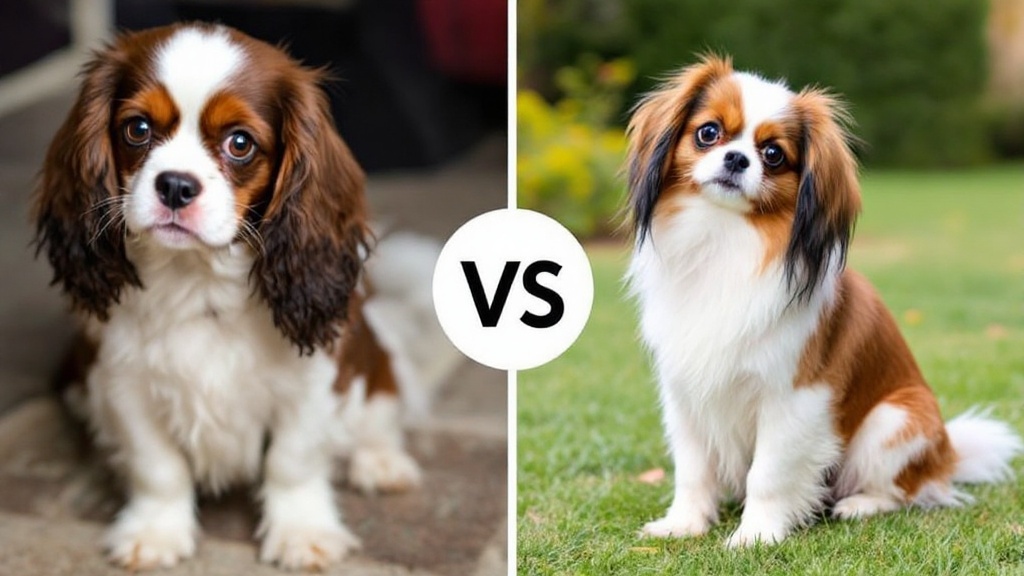Choosing between a German Shepherd and a Labradoodle? It’s not exactly a simple choice for most dog lovers.
Both breeds are popular, but they bring very different personalities to the table. German Shepherds are famous for loyalty and that protective streak, while Labradoodles are playful, friendly, and often a better bet for families worried about allergies.
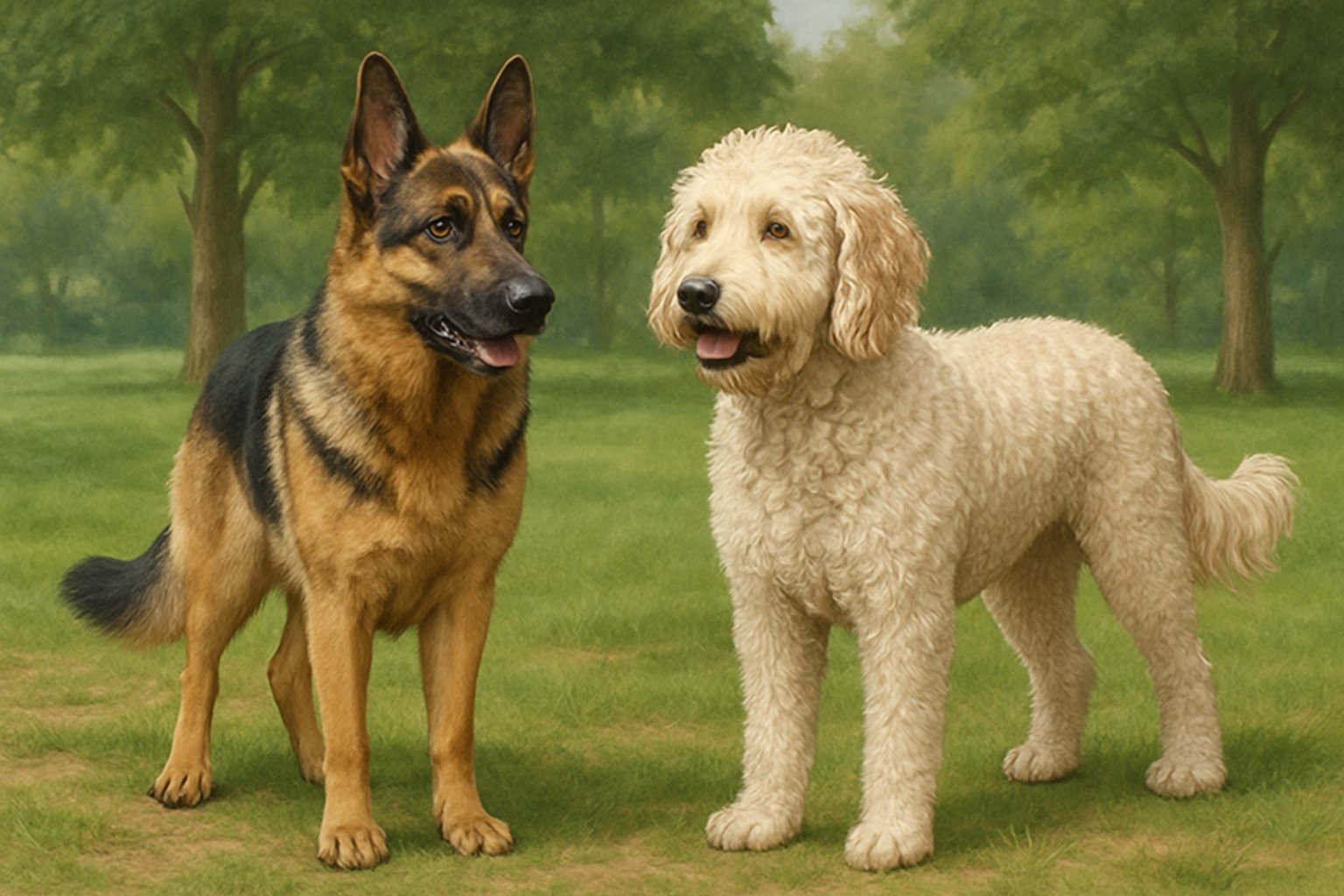
You might be asking yourself which breed actually fits your home best. Labradoodles usually shed less, so allergies might be less of an issue.
German Shepherds, on the other hand, are strong, smart, and love having a job. Learning about their quirks, care needs, and personalities can help you figure out which one makes sense for your lifestyle.
Key Takeaways
- German Shepherds and Labradoodles come from totally different backgrounds.
- Each breed brings its own look and personality to the mix.
- Health, grooming, and care routines aren’t the same for these two.
Breed Origins and History
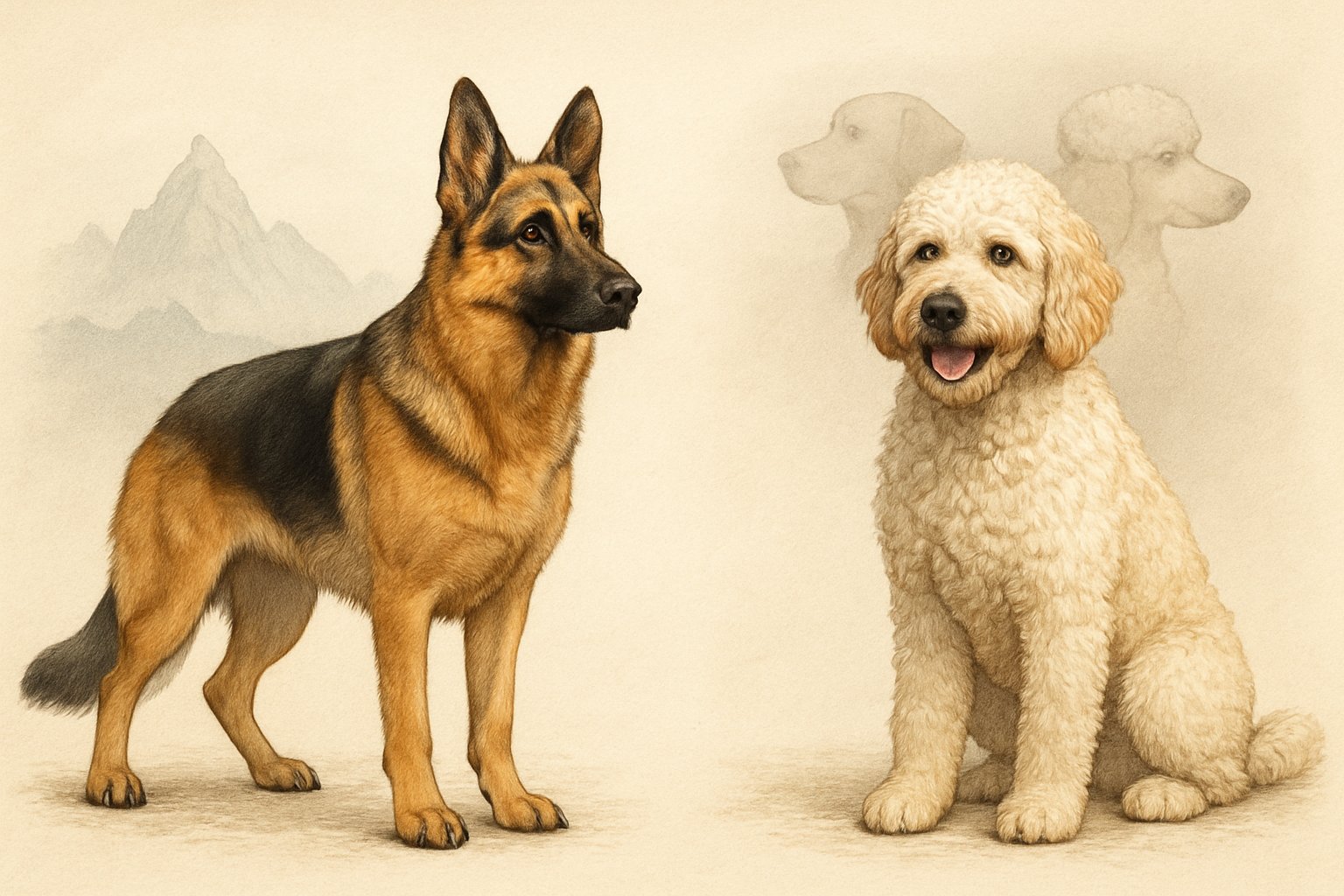
The German Shepherd and Labradoodle have origins shaped by what people needed from them. Their backgrounds say a lot about why they act and look the way they do.
Background of the German Shepherd
The German Shepherd got its start in Germany in the late 1800s. Max von Stephanitz wanted a smart, strong, and loyal dog to herd and protect sheep.
Pretty quickly, German Shepherds became favorites for police and military work thanks to their brains and courage. They learned to search, track, and help in rescues.
Today, you’ll find German Shepherds in family homes and service jobs. Their mix of smarts and athleticism makes them stand out.
Origins of the Labradoodle
The Labradoodle is a hybrid, born from crossing a Labrador Retriever with a Poodle. This mix first showed up in Australia during the 1980s.
Wally Conron, working for the Royal Guide Dogs Association of Australia, bred the first Labradoodle. He wanted a guide dog that wouldn’t trigger allergies, so he aimed for the Labrador’s friendliness and the Poodle’s low-shedding coat.
Early Labradoodles didn’t all look the same, but people liked their personalities. They don’t have a strict breed standard, but their popularity keeps climbing.
Development as Family Dogs
Both breeds have found their way into family life, but in different ways.
German Shepherds bring loyalty, protection, and a drive to work. Many families like how closely they bond with their people.
Labradoodles are playful and gentle, and they usually fit right in with kids and other pets. Their mixed background means you never know exactly what you’ll get, but most Labradoodles end up with the best traits from both sides.
Physical Characteristics
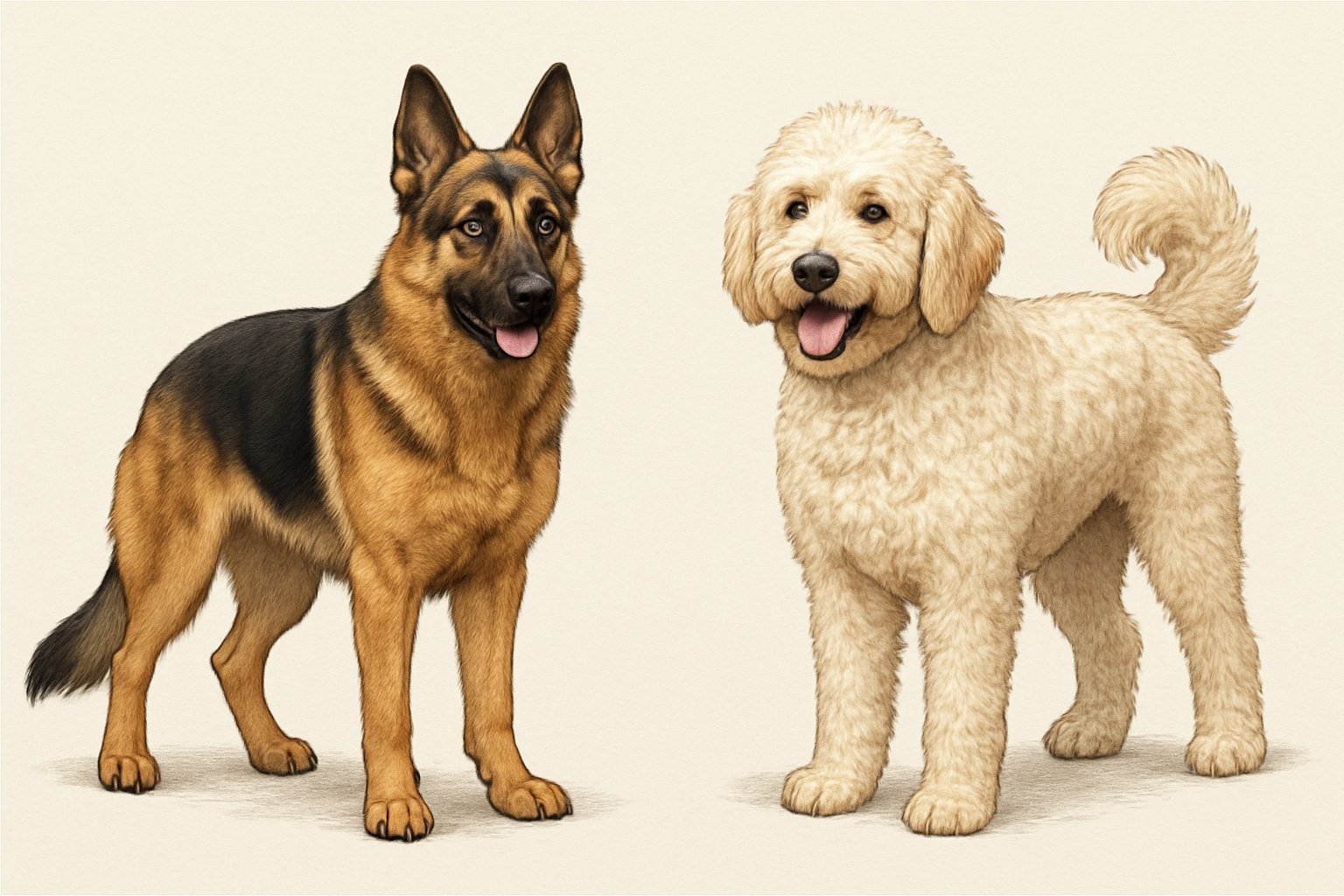
German Shepherds and Labradoodles look pretty different. Their size, build, coat, and shedding habits don’t really match up.
Size and Appearance
German Shepherds are big, muscular dogs. Males usually tip the scales at 65-90 pounds and stand 24-26 inches tall.
Females are a bit smaller, around 50-70 pounds and 22-24 inches high. They’ve got strong bodies, a straight or slightly sloped back, and those trademark pointy ears.
Labradoodles can be all over the map in size. Standard Labradoodles are usually 50-65 pounds and 21-24 inches tall.
Miniature Labradoodles? They might be just 15-25 pounds and 14-16 inches tall.
German Shepherds look a bit wolfy, with a bushy tail. Labradoodles have a softer, rounder face, floppy ears, and big, expressive eyes. Sometimes they’re slim like a poodle, sometimes stockier like a lab.
| Breed | Height (inches) | Weight (pounds) |
|---|---|---|
| German Shepherd | 22-26 | 50-90 |
| Labradoodle | 14-24 | 15-65 |
Coat Types and Colors
German Shepherds have a double coat—a dense undercoat and a rougher top layer. Most have medium-length fur, but a few have long hair.
Their colors? You’ll see black and tan, solid black, sable, and sometimes white.
Labradoodles are all about variety. Their fur might be wavy, curly, or straight, depending on the poodle parent. Curly coats look more like a poodle, straight coats lean toward the lab side.
Labradoodles come in a bunch of colors: cream, chocolate, black, apricot, red, silver, and more. Their coats can feel woolly or silky, and the type affects how much they shed.
Hypoallergenic Qualities
German Shepherds aren’t hypoallergenic. They shed a lot, especially in spring and fall, and that can be tough for people with allergies.
Labradoodles often get called hypoallergenic because of their poodle side. But honestly, not every Labradoodle is allergy-friendly.
Curly-coated Labradoodles usually shed less and might be easier for allergy sufferers. The straight or wavy-coated ones can shed more, just like a Lab.
No dog is 100% hypoallergenic, though. If allergies are a big worry, spend time around both breeds first. Regular grooming helps keep shedding and dander under control.
Temperament and Personality Traits
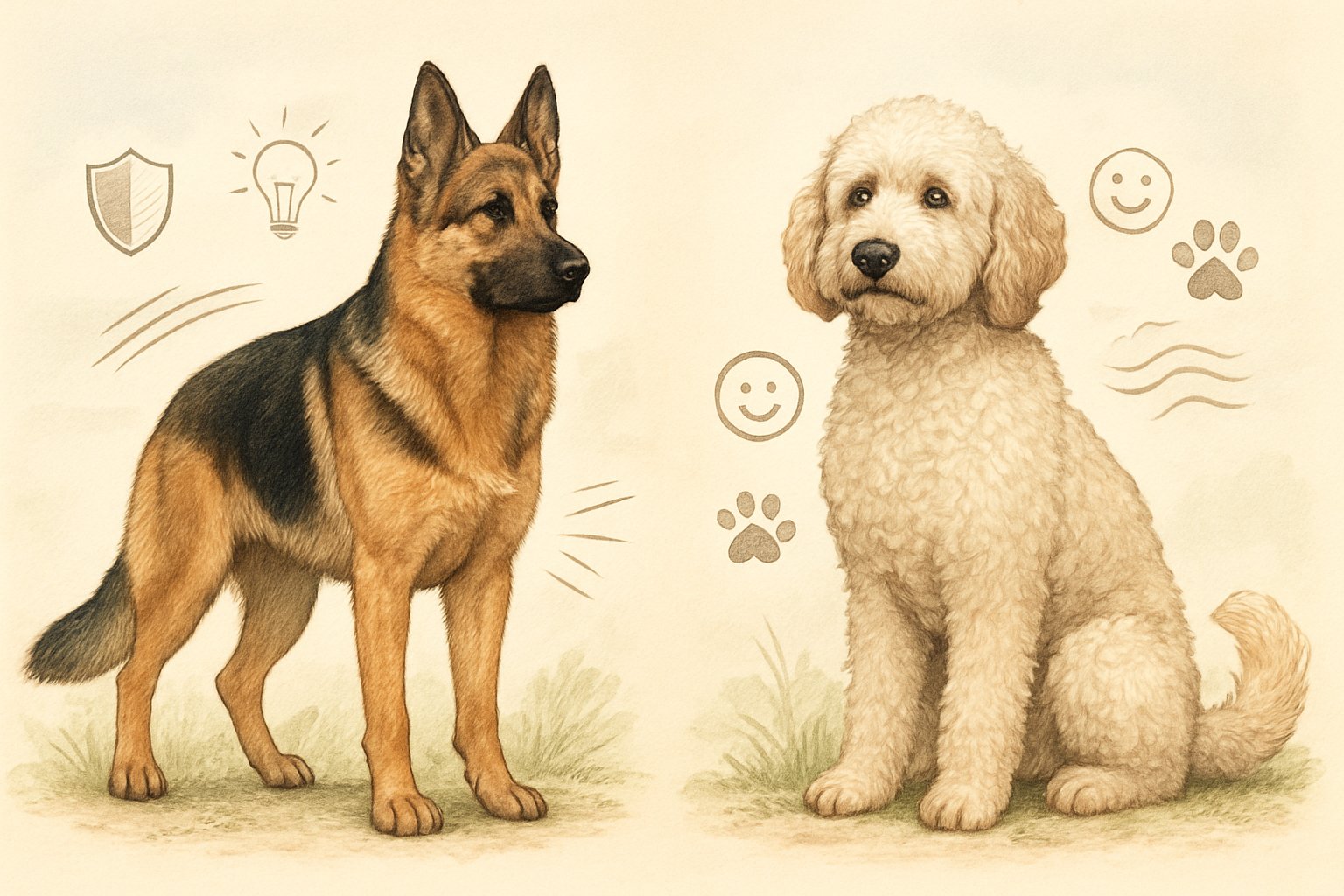
German Shepherds and Labradoodles are both loving, but their personalities can be pretty different. Depending on what you need, those differences might matter a lot.
Intelligence and Trainability
Both breeds are smart, but in their own ways.
German Shepherds are often called one of the smartest dog breeds. They pick up commands fast and really shine with structured training.
You’ll see them working as service, guide, and police dogs. They want to please, but they can have a stubborn streak. Consistency and clear rules go a long way.
Labradoodles are no slouches either. They’re easy to train, especially with positive reinforcement.
They love learning tricks and usually get the basics down quickly. Their playful energy can be distracting, so short, fun training sessions work best.
If you’re after a dog for complicated tasks, the German Shepherd is probably the better fit. For a smart, gentle companion who learns quickly, Labradoodles are a solid pick.
Family Compatibility
When it comes to families, both breeds have a lot to offer, but their needs aren’t the same.
Labradoodles are often great with families. They’re friendly, patient, and gentle with kids. Their easygoing nature makes them a good choice for homes with young children.
German Shepherds can be wonderful family pets too. They’re protective and keep an eye on the kids, but their guarding instincts mean they need early socialization.
Busy households suit them if there’s structure and routine. Active families who like hiking or jogging will get along well with a German Shepherd.
If you want a relaxed, social dog who’s good with visitors, Labradoodles are usually easier. German Shepherds are better if you want some extra protection and have time for training and exercise.
Loyal Companion Qualities
Both breeds are loyal, but they show it differently.
German Shepherds bond deeply with their main person. They’re alert and make excellent watchdogs.
If you want a dog who sticks close and keeps an eye on things, this is your breed. Their loyalty sometimes makes them cautious around strangers.
Labradoodles love everyone in the family. They’re not much for guarding, but they’re always happy to see people.
They’re gentle and excited to greet friends and family. Labradoodles want to be near you, often following you from room to room.
| Breed | Loyalty Level | Watchdog Ability | Best For |
|---|---|---|---|
| German Shepherd | Very High | Excellent | Security, strong bonds |
| Labradoodle | High | Low | Social, gentle companion |
Behavior Around Other Dogs
Got other pets? Here’s what to expect.
Labradoodles usually get along well with other dogs and pets. They’re rarely aggressive and often adapt quickly to a multi-pet home.
Early positive experiences make things even easier. Still, keep an eye out during play, especially with smaller pets—Labradoodles can get a bit too excited.
German Shepherds can get along with other dogs, but they’re more likely to be territorial, especially with other males. Early socialization is super important.
With the right introductions, they usually settle in, but some prefer sticking to dogs they already know.
Both breeds can live with other animals, but Labradoodles tend to adjust faster and with less fuss. German Shepherds need a bit more guidance and early social experience.
Health Issues and Care Needs
German Shepherds and Labradoodles each have their own health risks, daily care routines, and grooming quirks. These can really affect their quality of life.
Common Health Concerns
German Shepherds are prone to hip and elbow dysplasia, which can make walking painful. They’re also at risk for degenerative myelopathy, a nerve disease that affects the back legs.
Some develop allergies or heart problems too.
Labradoodles can inherit health problems from either parent breed. Hip dysplasia, eye issues like progressive retinal atrophy, and allergies are all possible.
Because Labradoodles often have floppy ears, ear infections are common. Regular ear checks and cleaning help a lot.
Ask breeders for health clearances, and stick to regular vet check-ups and a healthy diet to lower the risks.
Grooming Needs
German Shepherds have thick double coats and shed year-round—especially during those heavy shedding seasons. Brushing them a couple times a week helps keep the fur under control.
Baths every few months are enough unless they get really dirty.
Labradoodles need more grooming if they have curly coats—think 3-4 times a week to prevent mats. Straighter coats shed more but are easier to brush.
A trip to the groomer every 6-8 weeks is pretty standard for curly-coated Labradoodles.
Both breeds need regular ear cleaning, nail trims, and teeth brushing. It’s not glamorous, but it’ll keep them healthy.
Exercise Requirements
German Shepherds are active and smart. They need at least 1-2 hours of exercise every day.
Walks, runs, hikes, and training games keep them busy. If they get bored, they might become destructive or anxious.
Labradoodles have a lot of energy too. They love long walks, playtime, and running off-leash in safe spots.
How much exercise they need can depend on whether they take after the Poodle or Labrador side. Still, aiming for an hour a day is a good start.
Both breeds like mental challenges, such as puzzle toys or obedience work. If they don’t get enough activity, they can start acting out.
Comparison With Other Popular Breeds
Some dogs are purebreds, while others are hybrids. German Shepherds and Labradoodles each have their own strengths and challenges when you stack them up against other well-known breeds.
Similarities and Differences
German Shepherds stand out for their loyalty and intelligence. People often compare them to breeds like the Rottweiler, Doberman Pinscher, and Belgian Malinois—all alert, strong, and protective.
Labradoodles, being a mix of Labrador Retriever and Standard Poodle, come across as friendly and playful. They remind folks of the Goldendoodle, Labrador Retriever, and Golden Retriever.
Some breeds, like the Beagle, Cocker Spaniel, or Border Collie, have a reputation for high energy. Others, such as the Bulldog or English Bulldog, are more relaxed.
German Shepherds usually have a strong work ethic and need more training, similar to a Siberian Husky, Boxer, or Cane Corso. Labradoodles, while energetic, are often picked for their low-shedding coats, just like Poodles and other doodle mixes.
Hybrid and Purebred Dog Options
Choosing between a hybrid and a purebred dog changes things like grooming, health, and temperament. Labradoodles and other mixes (like Goldendoodles) tend to shed less and might have fewer genetic health issues.
Traits can really vary, though. With purebreds like the German Shepherd, Golden Retriever, or French Bulldog, you usually know what to expect for size, coat, and behavior.
Purebred Maltese, Yorkshire Terrier, and Pug stick to set breed standards. Mixed breeds, including Labradoodles and Shih Tzu mixes, show more variety.
Compared to smaller breeds like Chihuahua or Boston Terrier, both German Shepherds and Labradoodles are bigger dogs. That definitely affects how much space and exercise they need.
Choosing the Right Breed For Your Family
Your lifestyle and preferences should really guide your choice here. If you want a dog for protection, herding, or maybe even police work, a German Shepherd, Doberman Pinscher, or Belgian Malinois could be the right fit.
Looking for a social family pet instead? Breeds like the Labradoodle, Golden Retriever, Cavalier King Charles Spaniel, or Pembroke Welsh Corgi can be great options.
If allergies are an issue, a Labradoodle, Poodle, or other hypoallergenic breeds might help you breathe easier. Living in an apartment? Smaller dogs such as the Pomeranian, Dachshund, or French Bulldog usually handle tight spaces better.
Have kids at home? Calm, patient breeds like the Labrador Retriever, Bernese Mountain Dog, or Basset Hound are usually good choices.
Here’s a quick reference table for some common features:
| Breed | Size | Coat | Temperament | Shedding |
|---|---|---|---|---|
| German Shepherd | Large | Double | Loyal, Protective | Moderate |
| Labradoodle | Med-Large | Wavy/Curl | Friendly, Playful | Low-Mod |
| Golden Retriever | Large | Long | Gentle, Sociable | High |
| Bulldog | Medium | Short | Calm, Easygoing | Low |
| Beagle | Medium | Short | Curious, Friendly | Moderate |
| Poodle | Variable | Curly | Smart, Hypoallergenic | Low |

